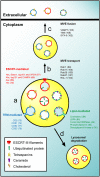Biogenesis and Function of T Cell-Derived Exosomes
- PMID: 27583248
- PMCID: PMC4987406
- DOI: 10.3389/fcell.2016.00084
Biogenesis and Function of T Cell-Derived Exosomes
Abstract
Exosomes are a particular type of extracellular vesicle, characterized by their endosomal origin as intraluminal vesicles present in large endosomes with a multivesicular structure. After these endosomes fuse with the plasma membrane, exosomes are secreted into the extracellular space. The ability of exosomes to carry and selectively deliver bioactive molecules (e.g., lipids, proteins, and nucleic acids) confers on them the capacity to modulate the activity of receptor cells, even if these cells are located in distant tissues or organs. Since exosomal cargo depends on cell type, a detailed understanding of the mechanisms that regulate the biochemical composition of exosomes is fundamental to a comprehensive view of exosome function. Here, we review the latest advances concerning exosome function and biogenesis in T cells, with particular focus on the mechanism of protein sorting at multivesicular endosomes. Exosomes secreted by specific T-cell subsets can modulate the activity of immune cells, including other T-cell subsets. Ceramide, tetraspanins and MAL have been revealed to be important in exosome biogenesis by T cells. These molecules, therefore, constitute potential molecular targets for artificially modulating exosome production and, hence, the immune response for therapeutic purposes.
Keywords: ESCRT complex; MAL protein; condensed membranes; exosomes; multivesicular endosomes; tetraspanins.
Figures


Similar articles
-
To be or not to be... secreted as exosomes, a balance finely tuned by the mechanisms of biogenesis.Essays Biochem. 2018 May 15;62(2):177-191. doi: 10.1042/EBC20170076. Print 2018 May 15. Essays Biochem. 2018. PMID: 29717057 Review.
-
The Regulation of Exosome Generation and Function in Physiological and Pathological Processes.Int J Mol Sci. 2023 Dec 23;25(1):255. doi: 10.3390/ijms25010255. Int J Mol Sci. 2023. PMID: 38203424 Free PMC article. Review.
-
Accessory ESCRT-III proteins are conserved and selective regulators of Rab11a-exosome formation.J Extracell Vesicles. 2023 Mar;12(3):e12311. doi: 10.1002/jev2.12311. J Extracell Vesicles. 2023. PMID: 36872252 Free PMC article.
-
Exosome Biogenesis in the Protozoa Parasite Giardia lamblia: A Model of Reduced Interorganellar Crosstalk.Cells. 2019 Dec 9;8(12):1600. doi: 10.3390/cells8121600. Cells. 2019. PMID: 31835439 Free PMC article.
-
Ceramide triggers budding of exosome vesicles into multivesicular endosomes.Science. 2008 Feb 29;319(5867):1244-7. doi: 10.1126/science.1153124. Science. 2008. PMID: 18309083
Cited by
-
Extracellular Vesicles and Epigenetic Modifications Are Hallmarks of Melanoma Progression.Int J Mol Sci. 2019 Dec 20;21(1):52. doi: 10.3390/ijms21010052. Int J Mol Sci. 2019. PMID: 31861757 Free PMC article. Review.
-
CNS endothelial derived extracellular vesicles are biomarkers of active disease in multiple sclerosis.Fluids Barriers CNS. 2022 Feb 8;19(1):13. doi: 10.1186/s12987-021-00299-4. Fluids Barriers CNS. 2022. PMID: 35135557 Free PMC article.
-
Modern Advances in CARs Therapy and Creating a New Approach to Future Treatment.Int J Mol Sci. 2022 Nov 30;23(23):15006. doi: 10.3390/ijms232315006. Int J Mol Sci. 2022. PMID: 36499331 Free PMC article. Review.
-
Small Extracellular Vesicles in Rat Serum Contain Astrocyte-Derived Protein Biomarkers of Repetitive Stress.Int J Neuropsychopharmacol. 2019 Mar 1;22(3):232-246. doi: 10.1093/ijnp/pyy098. Int J Neuropsychopharmacol. 2019. PMID: 30535257 Free PMC article.
-
Regulatory Role of Immune Cell-Derived Extracellular Vesicles in Cancer: The Message Is in the Envelope.Front Immunol. 2020 Jul 16;11:1525. doi: 10.3389/fimmu.2020.01525. eCollection 2020. Front Immunol. 2020. PMID: 32765528 Free PMC article. Review.
References
-
- Alonso R., Mazzeo C., Rodríguez M. C., Marsh M., Fraile-Ramos A., Calvo V., et al. . (2011). Diacylglycerol kinase α regulates the formation and polarisation of mature multivesicular bodies involved in the secretion of Fas ligand-containing exosomes in T lymphocytes. Cell Death Differ. 18, 1161–1173. 10.1038/cdd.2010.184 - DOI - PMC - PubMed
Publication types
LinkOut - more resources
Full Text Sources
Other Literature Sources
Research Materials

